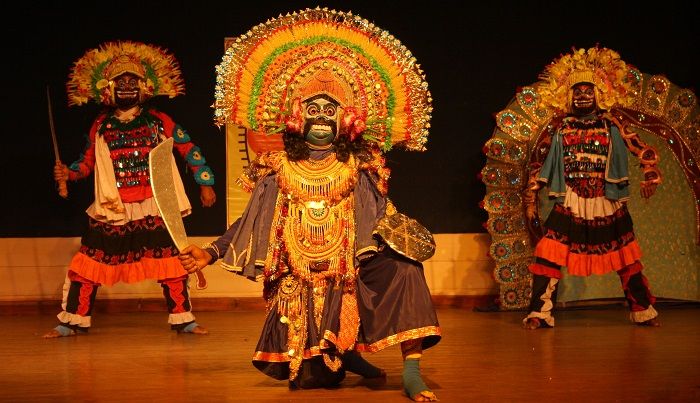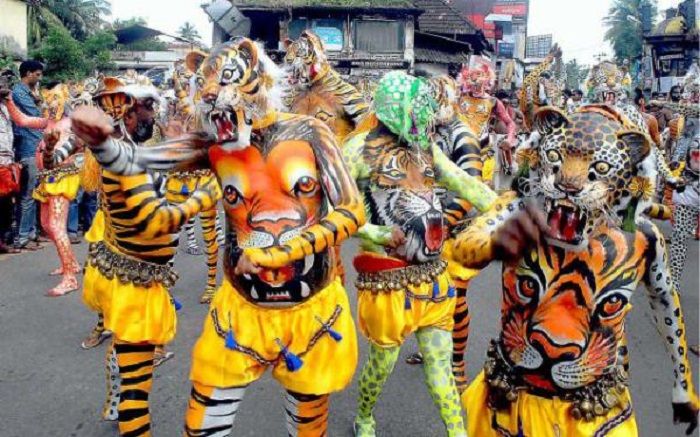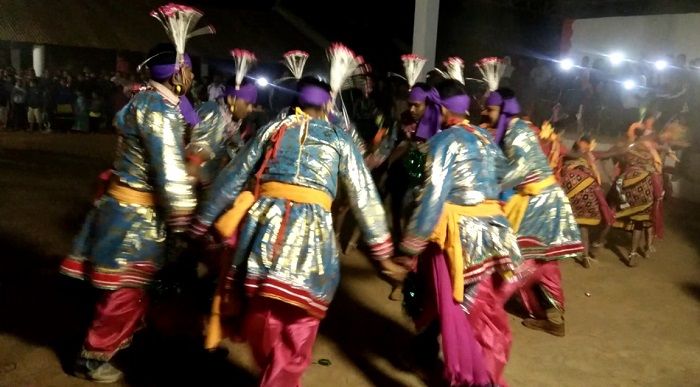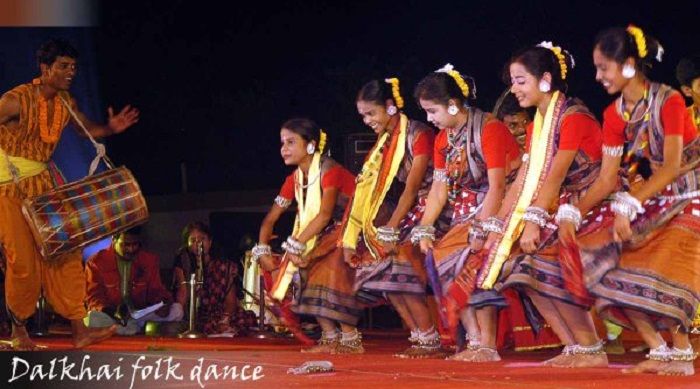Folk dances of East India have great historical significances as almost all dance forms from this part of the country are several hundred years old. For instance, the Ghumura dance from the Kalahandi district of Odisha is said to have existed from as early as 8000 BC, and this piece of information comes with the backing of a few archaeological evidences. Apart from the cultural and economic factors, there are some mythological connections associated with many of these dances from East India. Let’s now have a look at all the interesting folk dances of East India.
Chhau Dance
Region/Area: Odisha/ Jharkhand/ West Bengal
Occasion: Performed during festivals
Highlight: The dancers wear colorful masks
Traditionally performed by men, the main objective of this dance form is to celebrate martial arts. However, there is religious significance as well and more often than not these dances convey stories from Ramayana and Mahabharata. Chhau dance can be classified into three divisions based on the place it is performed; Mayurbhanj Chau of Odisha, Seraikella Chau of Jharkhand and Purulia Chau of Bengal. While the performers wear amazing masks in Jharkhand and Bengal, the dancers in Odisha don’t necessarily wear one while performing. Music flows in the form of percussion instruments like ‘Dhol’, ‘Nagara’ and wind instruments like ‘Shehnai’. Performing Chhau requires tremendous stamina and strength as the energy levels maintained throughout the performance is pretty high.

Gotipua
Region/Area: Odisha
Occasion: Performed in the praise of Jagannath and Krishna
Highlight: Boys are dressed as women
Gotipua is a unique dance form performed by boys. The reason we call it unique is because the performers are dressed as women. Not just that, but the performers go to the extent of growing their hair just to look like women so that their looks would help them present a more convincing performance. The boys are also trained to dance like women as it is an important aspect of the act. The dance comprises of acrobatic movements and involves building human pyramids. While the boys do the singing themselves, they are supported by musicians who often play instruments, such as cymbals and pump organs.

Baagh Naach or Tiger Dance
Region/Area: Odisha
Occasion: Performed during the Hindu month of Chaitra
Highlight: Dancers paint their entire body to look like tigers
Performed mainly in the month of Chaitra (a month in the Hindu calendar), Baagh Naach or simply Tiger Dance is a huge crowd puller as dancers paint their entire body to look like tigers. The dance moves and the body language of the dancers will often remind the viewers of tigers and their hunting nature. Musical instruments used are drums and bells and often a healthy competition ensues between dancers and the musicians.

Ghumra
Region/Area: Odisha
Occasion: Performed 15 days before the arrival of full moon in September
Highlight: The dancers play a typical drum which is far different from the usual drum
Ghumra dance starts 15 days before the arrival of the full moon in the month of September and continues till the full moon night. In early times, this particular folk dance played a key role in encouraging soldiers before they took to the battlefield. The dance usually conveys social messages and is performed by the men of the tribe. The dancers play an unusual drum which makes a peculiar sound as it is made using the skin of a reptile. There is another musician who plays a kettle-drum. The dancing happens around this musician who controls the tempo of the entire act.

Keisabadi
Region/Area: Odisha
Occasion: Performed during festivals
Highlight: The dance involves striking of sticks
This dance form belongs to the Sambalpur district of Odisha. Performed only by men, the songs used to support the dance performance conveys the love life of Lord Krishna and Goddess Radha. The songs are sung in the local language, Kosli. Sometimes the dancers wield sticks and use them to strike the sticks of the fellow dancers. Many formations are made by the dancers and the striking of sticks is in sync with the tempo of the song. The song is first sung by the leader of the group who is then joined by his fellow men.

Dhap
Region/Area: Odisha
Occasion: Weddings/ Recreation purpose
Highlight: Men and women belonging to different villages perform together
This folk dance of Sambalpur district gets its name from the musical instrument used in the dance performance – Dhap. Dhap is a percussion instrument made out of wood. While one end of the instrument is left open, the other end is covered with the skin of an animal. Both men and women take part in the performance. Interestingly, men and women belonging to different villages perform together which often brings people of different villages together.Though the dance is mainly performed during weddings, it is also used as a recreational activity.

Dalkhai
Region/Area: Odisha
Occasion: Performed during festivals
Highlight: Men address women as their girlfriend throughout the performance
Dalkhai is performed by women while men accompany them as musicians. Throughout the performance, men address the dancers as their girlfriends and often flirt with them. This is because the dance usually conveys the love stories of Radha and Krishna. It also conveys important episodes from the Hindu epics – Ramayana and Mahabharata. Dalkhai dance is usually performed to please Goddess Durga and hence the dancers worship the Goddess before taking the stage. They also fast during the days on which the dance is performed. Dalkhai is performed during Hindu festivals, such as Dussera, PhagunPuni, Bhaijiuntia and Nuakhai.

Gambhira Dance
Region/Area: West Bengal
Occasion: Festivals
Highlight: The performance highlights social problems in a satirical manner
Gambhira is performed by the Maldah people of West Bengal and usually involves two dancers. Traditionally, this dance form had its performers take up mythological characters like Shiva and Parvati. Thanks to the evolution of this dance form over the years, today the characters portrayed by the dancers are maternal grandfather and his grandson. The performance is formulated as a conversation between these two characters. The dancers convey a host of social issues in a satirical manner.

Brita Dance
Region/Area: West Bengal
Occasion: Worship
Highlight: Dance takes the form of thanksgiving
Also known as Vrita dance, this art form is performed by women in temple premises to thank the local deity after recovering from a contagious disease like small pox or chicken pox. This dance is a form of thanksgiving. It is one of the most important folk dances of West Bengal as it is considered sacred. Women also perform Brita dance to get their wishes fulfilled. Once their wish is fulfilled, they once again perform the same dance to thank the deity.
Alkap
Region/Area: West Bengal
Occasion: Performed during the Gajan festival of Lord Shiva
Highlight: The performance has five interesting parts
Alkap is a combination of dance and music, and is presented in a theatrical manner. The performers, comprising of ten or twelve men and boys, are led by a leader. The group also involves three boys, two singers and musicians. The performance has five interesting parts and often conveys the living conditions of rural Bengal.
Domni
Region/Area: West Bengal
Occasion: Performed during festivals
Highlight: Portrayal of day-to-day life in a satirical way
Domni is performed in the Malda district of West Bengal. During the performance, the dancers portray the characters of husbands, wives, moneylenders and so on. The main objective is to convey in a satirical way the events that happen in day-to-day life. Musical instruments like pump organ, flute and dholak (type of a drum) are used.
Jhijhian Dance
Region/Area: Bihar
Occasion: Performed while worshipping Lord Indra
Highlight: The dancers carry lanterns or earthen pots on their head
Performed in Bihar, Jhijhian involves women dancers carrying lanterns or earthen pots on their head. The only objective of this dance form is to invoke Lord Indra at a time of severe drought. The dance is also performed whenever the village faces water shortage which leads to bad harvest. Musical instruments used to support the dance are pump organs, bansuri, dholak and other percussions.




